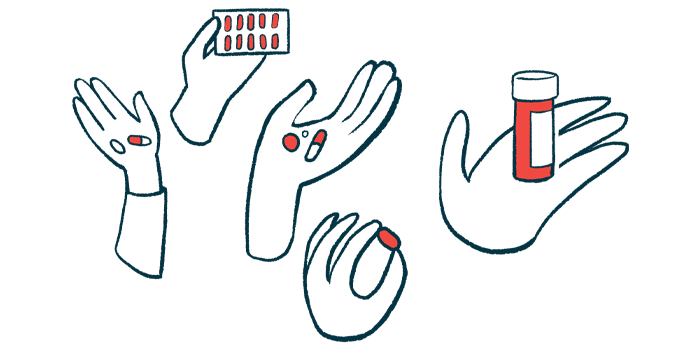Phase 1 Safety Study Clears Path to Test Utreloxastat in ALS Patients
Recruitment is underway for CARDINALS Phase 2 clinical trial

Utreloxastat (PTC857), an investigational therapy for people with amyotrophic lateral sclerosis (ALS), was safe, well tolerated, and displayed promising pharmacological properties in healthy people, according to a first-in-human Phase 1 study.
Based on these findings, the therapy’s developer, PTC Therapeutics, has launched a Phase 2 trial (NCT05349721) to evaluate it in up to 258 ALS adults, ages 18–80. Recruitment is underway at sites in California, Florida, Kansas, and Texas.
Results from the Phase 1 trial were shared in the study, “First-in-Human Studies of Pharmacokinetics and Safety of Utreloxastat (PTC857), a Novel 15-Lipooxygenase Inhibitor for the Treatment of Amyotrophic Lateral Sclerosis,” which was published in Clinical Pharmacology in Drug Development.
The nerve cells that control muscle movement, called motor neurons, are lost in ALS, leading to symptoms of muscle weakness that affect motor function, speaking, swallowing, and eventually, breathing.
A central mechanism behind motor neuron loss is oxidative stress — cell damage caused by an excess of highly reactive oxygen-containing molecules generated by normal cellular processes. Oxidative stress increases the production of an enzyme called 15-lipoxygenase (15-LO), triggering several processes known to contribute to motor neuron death.
Utreloxastat is designed to block the action of 15-LO, reducing further oxidative stress, preventing motor neuron death, and slowing or preventing disease progression. So far, promising preclinical studies in multiple animal models have supported the therapy’s further evaluation in human clinical trials.
PTC launched a first-in-human clinical trial to assess utreloxastat’s safety, tolerability, and pharmacokinetics (PK), or how it moves into, through, and out of the body, in healthy participants.
SAD, MAD, and food studies
The Phase 1 trial had three parts. Part 1 was a single-ascending-dose (SAD) study that included 40 people (19 men, 21 women). Participants were randomly divided into four groups of 10 with eight in each group receiving a single dose of utreloxastat (100, 250, 500, or 1,000 mg), and two receiving a placebo.
A medium-fat breakfast was provided before dosing, and blood samples were collected before and at several points after exposure.
Across all doses, utreloxastat showed dose-dependent increases in maximum concentrations, which were observed in the bloodstream about four hours after dosing. Half-life, the time it takes for utreloxastat levels to be reduced by half, was consistent at all doses, ranging between about 22–25 hours.
Part 2 was a multiple-ascending-dose (MAD) study with 30 people (19 men, 11 women) who were randomly divided into three groups of 10 to receive 14 days of treatment. Participants received utreloxastat at either 250 mg twice daily, 500 mg once daily, 150 mg twice daily/once daily, or a placebo.
Following multiple doses, the rate at which utreloxastat entered the bloodstream and the time to reach maximum levels were similar to the first doses. In the 250 mg twice-daily and 500 mg once-daily regimen groups, concentrations approached continuous exposure after seven consecutive days of dosing.
Part 3 tested the impact of food on utreloxastat’s pharmacological properties in 12 people following a single dose (500 mg) under fasting and low- and high-fat conditions.
Utreloxastat was absorbed into the bloodstream faster with food, but food didn’t alter the time to reach maximum levels or the drug’s clearance from the body. There were no differences in exposure between men and women participants, regardless of food intake.
Following a single dose of up to 1,000 mg and multiple doses for 14 days, no marked safety signals were reported. All side effects were considered mild and resolved by the end of the study. No deaths or treatment-emergent serious side effects that led to discontinuation occurred. No abnormal ECG readings for heart function were detected.
During the MAD study, levels of high-density lipoprotein (HDL) — known as good cholesterol — and total cholesterol followed a dose-dependent decrease after multiple utreloxastat doses, but those decreases reversed when exposure stopped. No clinically significant side effects were associated with these observations.
“These PK [pharmacokinetics] and safety data indicate that utreloxastat is an appropriate candidate for further development for the treatment of ALS,” the researchers wrote.
The ongoing Phase 2 study, called CARDINALS, will investigate whether utreloxastat, given twice daily (250 mg) for 24 weeks (about six months), outperforms a placebo at slowing progression.
The main goal is to determine functional decline, as assessed by changes in ALS Functional Rating Scale-Revised (ALSFRS-R) scores. Secondary measures include safety, changes in lung function, muscle strength, cognitive abilities, and quality of life, as well as time to breathing support, and survival.
Those who complete CARDINALS can join an open-label extension study and continue receiving utreloxastat for 28 weeks (about seven months).







